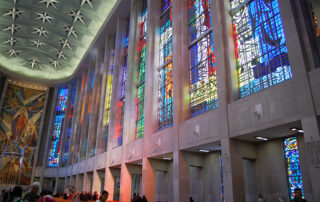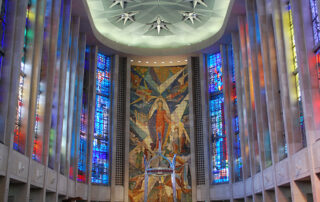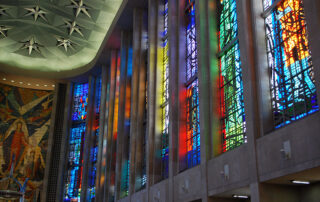Cathedral of St. Joseph
Dedicated on May 15, 1962, the Cathedral of St. Joseph stands on the site of the old Cathedral destroyed by fire on December 31, 1956. Designed by Eggers and Higgins of New York, it rises 281 feet from the sidewalk. The stainless steel cross is 25 feet high. The building is 284 feet long at the extreme end and 156 feet wide from east to west. It is constructed of reinforced concrete, sheathed with Alabama limestone. The grille work in the tower is of the same material and houses 12 carillon bells designed by Verdin of Cincinnati.




A heroic likeness of St. Joseph, Patron of the Universal Church as well as of the Archdiocese and the Cathedral, stands over the main doors.
The theme of “Christ the Savior” is carried in the windows in the main nave. The twenty four great windows show the Savior present in the Gospel: The coming of the Savior, the Savior and sinner, the Savior as teacher of all, the Savior’s triumph over death (on the east side); the Savior and work, the Savior and the joys and sorrows of life, the Savior instituting the Holy Eucharist, and finally the Savior’s redeeming sacrifice (on the west side). Two large windows behind the altar contain symbols of the Sacraments. Designed by Jean Barillet of Paris, the windows are 67 feet high and 13 1/2 feet wide. The glass is embedded in concrete, instead of the usual lead cames.
 The beginnings of the Cathedral of St. Joseph coincide with the division of the Diocese of Hartford in 1872, when Providence, Rhode Island, became a separate diocese. Pope Pius VIII established the Diocese of Hartford in 1843 and named Rev. William Tyler, the Vicar General of Boston, as its first bishop. After seeing how few Catholics (600) lived in Hartford, Bishop Tyler petitioned Rome to reside in Providence, Rhode Island, where about a thousand Catholics were in residence. His unusual request was granted. His successor, Bishop Bernard O’Reilly (1850-1856), continued to maintain residence there as did Bishop Francis P. McFarland, who succeeded him.
The beginnings of the Cathedral of St. Joseph coincide with the division of the Diocese of Hartford in 1872, when Providence, Rhode Island, became a separate diocese. Pope Pius VIII established the Diocese of Hartford in 1843 and named Rev. William Tyler, the Vicar General of Boston, as its first bishop. After seeing how few Catholics (600) lived in Hartford, Bishop Tyler petitioned Rome to reside in Providence, Rhode Island, where about a thousand Catholics were in residence. His unusual request was granted. His successor, Bishop Bernard O’Reilly (1850-1856), continued to maintain residence there as did Bishop Francis P. McFarland, who succeeded him.
As the number of Catholics grew in both Connecticut and Rhode Island, Bishop McFarland sought the division of the Diocese. Rome acceded by appointing Rev. Thomas Hendricken, who had served in Connecticut for many years, the first Bishop of Providence. Bishop McFarland then moved to Hartford (1872).
On his arrival in Hartford Bishop McFarland purchased the old Morgan estate on Farmington Avenue for $75,000 to provide ground for building a cathedral, an Episcopal residence, and a motherhouse for the Sisters of Mercy, whose services he had procured while in Providence. To provide them with a home in Hartford, he decided to build them a convent first; their chapel would serve as the pro-Cathedral while the cathedral was being constructed.
Though Bishop McFarland dedicated the pro-Cathedral and planned the building of the Cathedral, it was his successor, Bishop Thomas Galberry, O.S.A. (1876), who broke ground on August 30, 1876, and laid the first stone on September 13 of that year. A vast assembly of bishops, priests and laity gathered for the laying of the cornerstone on Sunday, April 29, 1877. Almost a year later, on February 10, 1878, the bishop dedicated the basement of the Cathedral. The sacristy provided a crypt where deceased bishops of the diocese were to be buried. Bishop McFarland’s body was exhumed from his burial spot in front of the convent and transferred to the crypt. Following his death on October 10, 1878, Bishop Galberry was buried next to his predecessor.
Upon his consecration as Bishop of Hartford on August 10, 1879, Bishop Lawrence S. McMahon found not only an incomplete cathedral but also a $60,000 debt, which he soon liquidated. He then continued to execute the building plans of his predecessors. Thirteen years later, on May 8, 1892, Bishop McMahon consecrated the Cathedral. In attendance was an impressive array of dignitaries: Archbishop Edward C. Fabre of Montreal, Bishop Patrick Ludden of Syracuse, New York, Bishop L.F. Lafleche of Three Rivers, Canada, Bishop Matthew Harkins of Providence, Rhode Island, Bishop Charles E. McDonnell of Brooklyn, and Bishop John J. Williams of Boston.
The renowned Patrick C. Keely was the architect who planned the Cathedral, cruciform in shape and early Gothic in design. Approached by well-laid walks, the cathedral had three double doorways leading to the tiled vestibule. Its exterior was of Portland rough brown stone with stone ornamentation. Square towers, surrounded by low battlements, recalled those of the Church of Notre Dame in Montreal, Canada. The entire length of the Cathedral was 268 feet; its width in the transcept, 178 feet and in the nave, 93 feet. Its frontage occupied 123 feet; and its height from the center of the ceiling to the floor, 90 feet. Its seating capacity was 2,000. It was generally believed that this cathedral was one of the best achievements of architect P.C. Keely.
The cathedral remained substantially unchanged until 1938, when it became apparent that soil conditions had endangered the foundation. Renovation and a vast shoring up project ensued under Bishop Maurice F. McAuliffe to make the cathedral not only safe but more beautiful as well. While hundreds of piles were driven from the floor to ensure a proper foundation for the structure, the lower church was closed. After it was refurbished and ready for use, the upper church was closed for corrective work and renovation. This herculean work was completed in time for Christmas, 1939.
 During a morning Mass on December 31, 1956, worshipers complained of smelling a fire. Firefighters were summoned but they could not discover its source until late morning when flames shot up into the wooden ceiling. Windows shattered as by an explosion; the roof fell, and everything within the cathedral suffered from the uncontrolled flames. Before late afternoon all that remained was a charred, smoldering, ice-encrusted ruin. The mother church of the Archdiocese of Hartford, which had witnessed the consecration of bishops, the ordination of hundreds of priests, and the taking of vows by hundreds of religious was no more. Expert structural engineers having demonstrated that nothing could be salvaged, the walls were demolished and the site cleared. The cornerstone was moved to rest near the site where the new cathedral would stand.
During a morning Mass on December 31, 1956, worshipers complained of smelling a fire. Firefighters were summoned but they could not discover its source until late morning when flames shot up into the wooden ceiling. Windows shattered as by an explosion; the roof fell, and everything within the cathedral suffered from the uncontrolled flames. Before late afternoon all that remained was a charred, smoldering, ice-encrusted ruin. The mother church of the Archdiocese of Hartford, which had witnessed the consecration of bishops, the ordination of hundreds of priests, and the taking of vows by hundreds of religious was no more. Expert structural engineers having demonstrated that nothing could be salvaged, the walls were demolished and the site cleared. The cornerstone was moved to rest near the site where the new cathedral would stand.
 A fund-raising campaign involving parishes and other donors was soon inaugurated. Archbishop Henry F. O’Brien engaged Eggers and Higgins, of New York, as architects of a new cathedral. In August 1957, they submitted several designs; in December the choice of contemporary design with a flavoring of the traditional was announced.
A fund-raising campaign involving parishes and other donors was soon inaugurated. Archbishop Henry F. O’Brien engaged Eggers and Higgins, of New York, as architects of a new cathedral. In August 1957, they submitted several designs; in December the choice of contemporary design with a flavoring of the traditional was announced.
Archbishop O’Brien presided over the formal ground breaking on September 8, 1958. During the 1957-1959 period of construction cathedral parishioners attended Sunday Mass in the auditorium of the Aetna Life Insurance Company building, directly opposite the cathedral site. Daily Masses were celebrated in the school auditorium. The lower church was blessed by Auxiliary Bishop John F. Hackett on December 24, 1960, and at midnight Archbishop O’Brien offered the first Pontifical Mass there.
Meanwhile the work on the main cathedral, which was to seat 1,750 proceeded steadily. On February 10, 1961, Archbishop O’Brien consecrated 12 carillon bells, cast in Holland; on October 3, 1962, Auxiliary Bishop Hackett laid the cornerstone, while on April 3, 1962, the Archbishop blessed the cross for the tower. Finally on May 15, 1962, the Auxiliary Bishop consecrated the completed edifice.
Since the dedication of the first Cathedral in 1878, the Cathedral of St. Joseph has been the scene of many important and historic events in the life of the Church in Connecticut. It has witnessed
- the consecration of Bishops Lawrence S. McMahon, Michael Tierney, John J. Nilan, Maurice F. McAuliffe, Henry J. O’Brien (both as bishop and first archbishop), John F. Whealon as second archbishop, and Daniel A. Cronin as third archbishop; Henry J. Mansell as fourth archbishop; and Leonard P. Blair as fifth archbishop; the welcome for Christopher Coyne as coadjutor archbishop to succeed as sixth archbishop.
- the consecration of Auxiliary Bishops John G. Murray (later Archbishop of St. Paul, Minnesota), John F. Hackett, Joseph F. Donnelly, Peter A. Rosazza, Paul S. Loverde, Christie Macaluso and Juan Miguel Betancourt;
- the consecration of Missionary Bishops Paul J. Girouard, M.S. and Edward A. McGurkin, M.M.;
- the ordination of priests for the archdiocese;
- investiture in the religious habit and the taking of vows by the Sisters of Mercy; and finally,
- religious services for numerous church organizations. It has hosted Bishop Desmond Tutu of South Africa, in an ecumenical prayer service.
Rectors of the Cathedral include Reverends Joseph B. Reid, E.M. Hickey*, Michael F. Kelly, William A. Harty, Philip J. McCabe, Walter J. Shanley, Thomas S. Duggan, D.D., V.G., William H. Flynn, William J. Collins, V.G., John S. Kennedy, Denis P. Ferrigno, Charles B. Johnson, Christie A. Macaluso, Daniel J. Plocharczyk, Robert Bergin, Monsignor John J. McCarthy, James Shanley, Thomas Ginty, Kevin Donovan, Daniel McLearen and John Melnick.
* From Msgr. Wm. Kearney’s notes: When Rev. Joseph B. Reid, Secretary to Bishop McFarland, became the first rector of the Cathedral, he was assisted in the administration of the parish by Rev. E.M. Hickey. Fr. Hickey came to Hartford from the Newark Diocese and after leaving here joined the Diocese of Wheeling, West Virginia.
Chronology of the Cathedral
Mass
Weekend
Sunday 8:30 and 11:00 am
Weekday
Monday – Friday 7:30 am; 12:10 pm
Saturday 9:00 am
Holy Day
7:30 am; 12:10 pm
Adoration
Wednesday
8:00 am -12:00 pm
Confession
Saturday Confessions
3:00-3:30 pm
Baptism
Sundays after 11:00 am Mass
Visit the Cathedral of Saint Joseph web site.
Cathedral of St. Joseph
140 Farmington Avenue
Hartford, Connecticut
